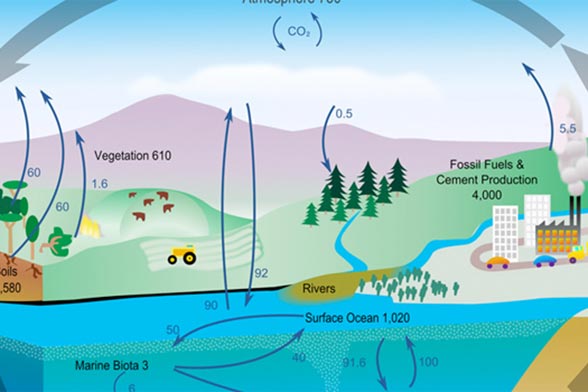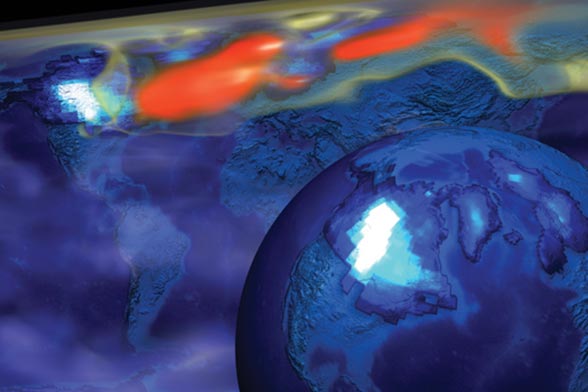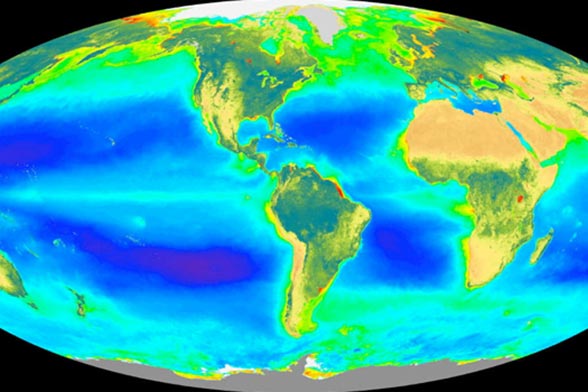The Center for Climatic Research (CCR) is an interdisciplinary research center with strong expertise in the areas of climate modeling and climate dynamics, climate impacts, past climates, carbon cycling, terrestrial and aquatic ecosystems, and feedbacks between the atmosphere and earth’s surface.
CCR has a distinguished tradition of over 50 years of excellence in climate science. Its past directors include fellows of the American Geophysical Union and members of the National Academy of Sciences, while its alumni are found in leading atmospheric and geoscience departments around the country. CCR faculty and scientists are at the leading edge of their disciplines.
Carbon Cycling

CCR’s multidisciplinary approach allows its carbon cycle researchers to benefit from cross-fertilization of ideas across biology, ecology, atmospheric chemistry, oceanography, limnology, and paleoclimatology.
CCR has a long history of research into these topics from modeling and observational perspectives, with a particular focus on combining long-term carbon cycle observations with simulations of past, present, and future changes to ocean and land carbon sinks and feedbacks to climate and ecological systems.
These investigations includes those focused on the Great Lakes, the global oceans, paleobotany, fossil fuel chemical transport modeling, land surface vegetation change feedbacks, and direct terrestrial carbon/water cycle measurement and synthesis with eddy covariance flux towers.
Climate Dynamics

Understanding the mechanisms responsible for climate variability and change is a major research theme in CCR. Our center has been at the forefront of unraveling the causes of past, present, and future variations in climate, using an array of modeling and statistical tools.
Researching regional climate change across the world, CCR scientists are currently studying the drivers and predictability of monsoon circulations, El Niño-Southern Oscillation, African vegetation dynamics, Middle Eastern dust storms, Great Lakes warming trends, and Arctic climate change.
Climate Impacts and Vulnerability

We are living in a world of changing climates. CCR helps agencies, businesses, NGOs, and individuals prepare for and adapt to climate change by providing state-of-the-art science and expert knowledge.
CCR is an active participant in the Wisconsin Initiative on Climate Change Impacts, developing statistically and dynamically downscaled climate projections for Wisconsin and the broader region to guide vulnerability assessments (e.g. Green Bay ecosystem health and hypoxia risk) and the formation of effective adaptation strategies.
For the broader Great Lakes Basin, CCR researchers have been investigating impacts of climate change on lake levels, lake temperatures, lake-effect snow, and wildlife species vulnerability.
At a global scale, we are studying Arctic amplification and resulting impacts on the mid-latitude circulation and weather extremes.
Oceanography and Limnology

The ocean covers two-thirds of the Earth’s surface, and plays a central role in the global climate by regulating Earth’s temperature and biogeochemical cycles. In the northern United States, the Great Lakes have similar effects.
In CCR, oceanographers work with atmospheric scientists to study how the global ocean and the Great Lakes regulate Earth’s temperature and biogeochemical cycles, at regional to global scales. Limnologists, ecologists, and carbon cycle scientists study how water levels and carbon chemistry in the Great Lakes are being modified by climate variability and ecosystem alteration.
Timescale studies range from the distant past into the future. Our investigations are focused in the North Atlantic, the global oceans and in the Great Lakes, and our primary tools include fieldwork, satellite data, and the numerical models that we build and analyze.
Past Climates

CCR has been an internationally recognized leader in paleoclimatic research since its founding in 1962. Founding Director Reid Bryson was one of the first to highlight the vulnerability of early agricultural societies to climate variability, while former Director John Kutzbach’s work established that past variations in the strength of subtropical monsoons are strongly controlled by variations in the earth’s orbit.
Today, CCR researchers are at the forefront of using earth system models and proxy data extracted from the geological record to gain insights into the natural and anthropogenic processes controlling climate variability, and the effects of past climate change on species and ecosystems.
Surface-Atmosphere Feedbacks

CCR has extensively studied surface-atmosphere interactions linking vegetation, soil moisture, snowpack, lakes, and topography to atmospheric processes.
Ecosystem-atmosphere exchanges of trace gases have been measured at flux towers across Midwestern wetlands/forests. Modeling and statistical methods have been applied to explore the impact of Rocky Mountain snowpack on the North American monsoon, the Great Lakes’ influence on regional climate, the capacity of afforestation to slow anthropogenic warming, the global monsoons’ sensitivity to vegetation feedbacks, and oceanic versus terrestrial drivers of drought.
The observational and remote sensing analysis of Middle Eastern dust storms has offered the potential for seasonal prediction. Using models and proxy data, CCR has studied abrupt African climate-ecosystem change during the mid-Holocene and impacts of Tibetan uplift on the Asian monsoons.